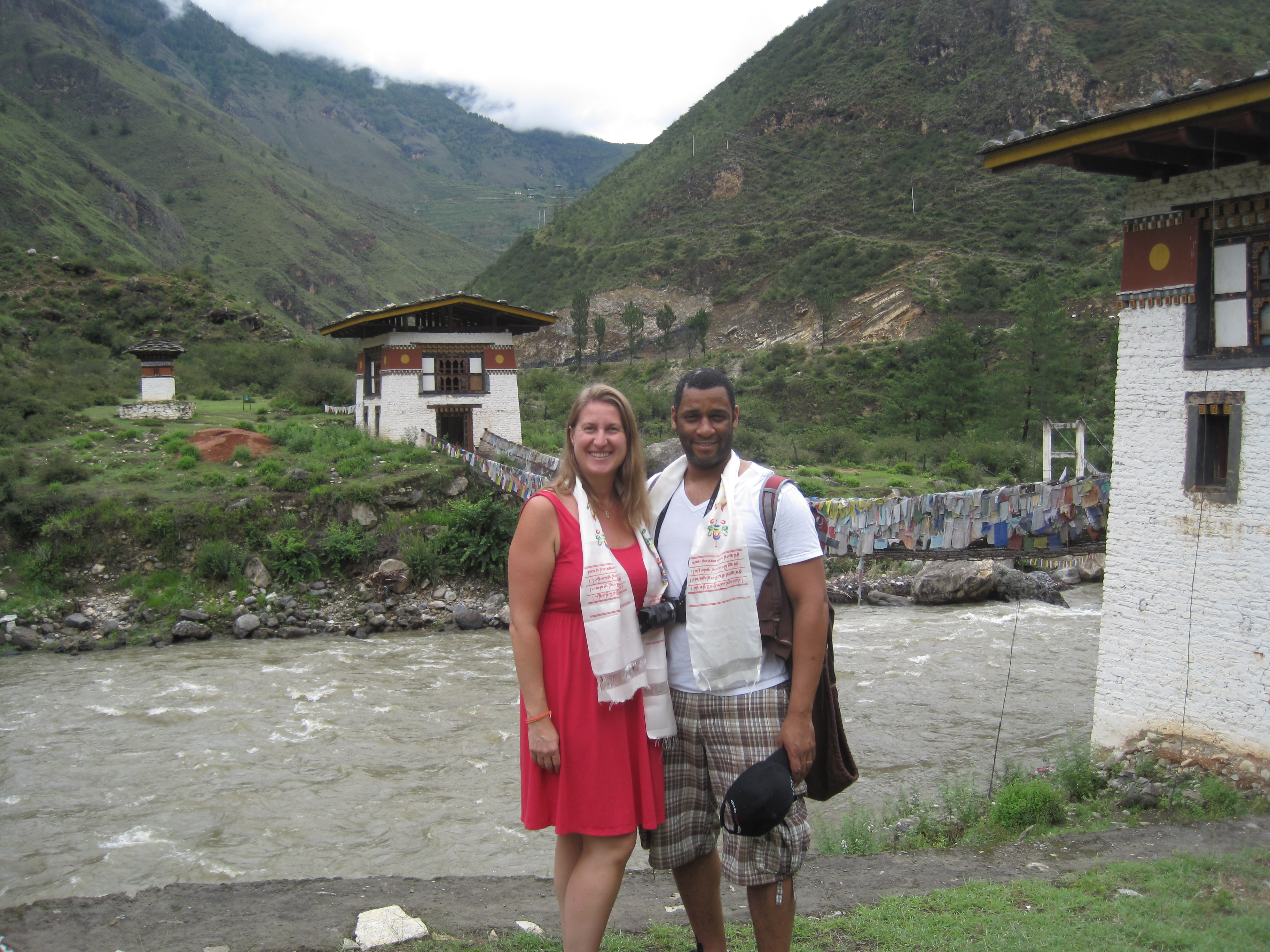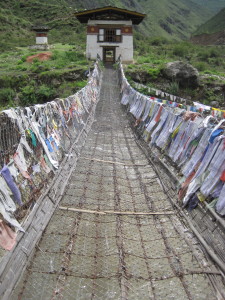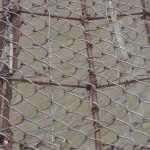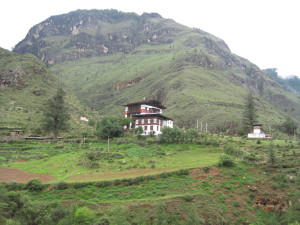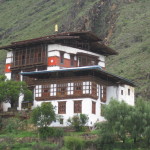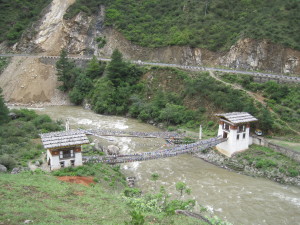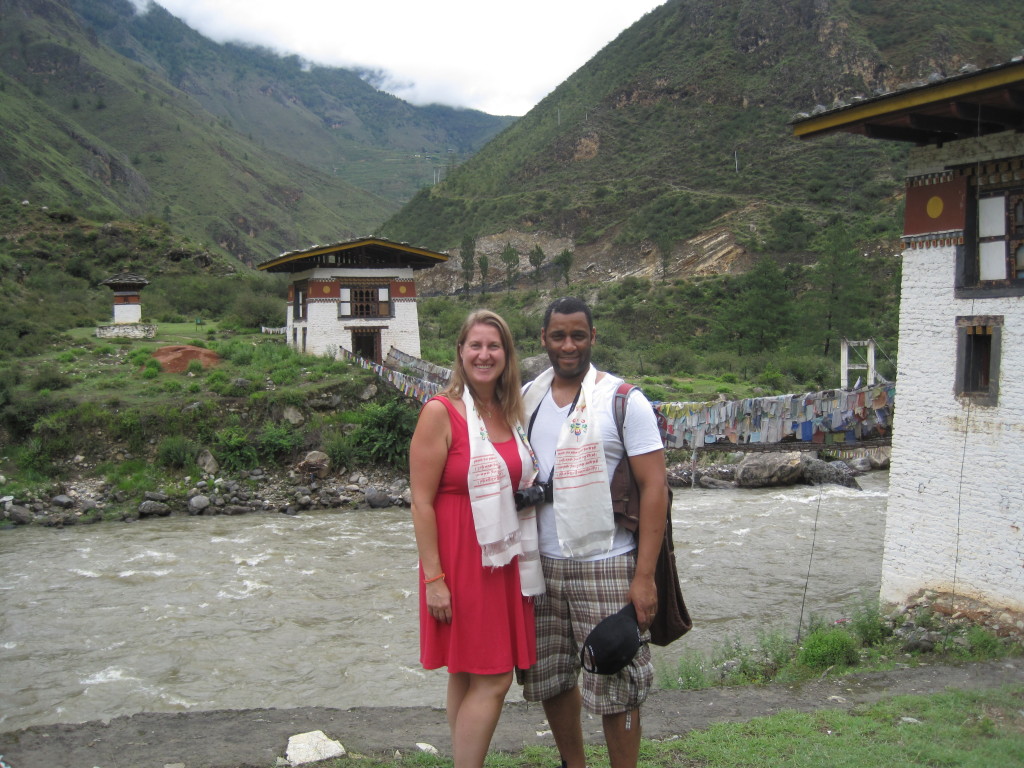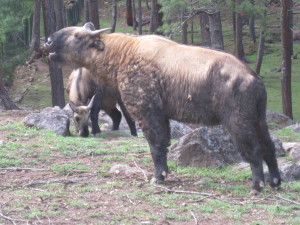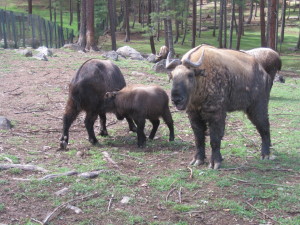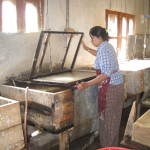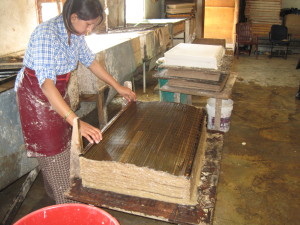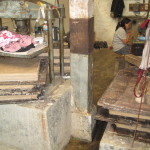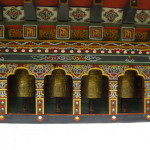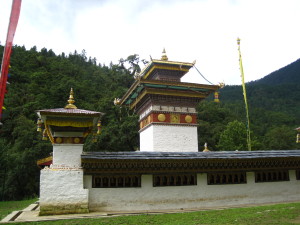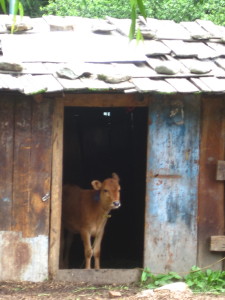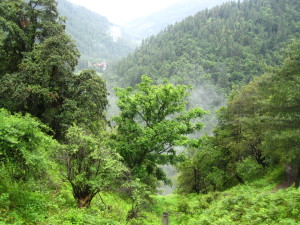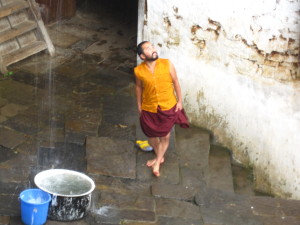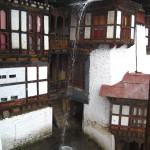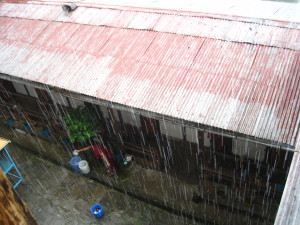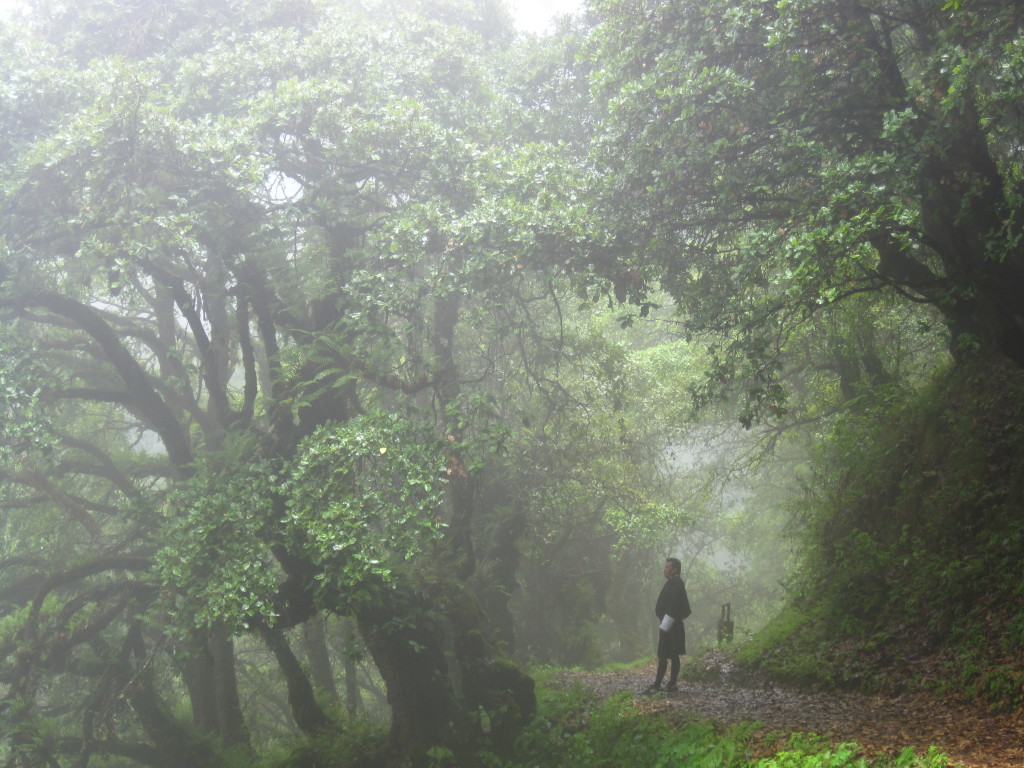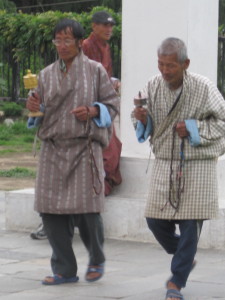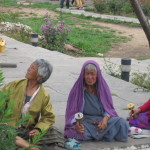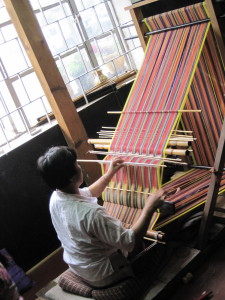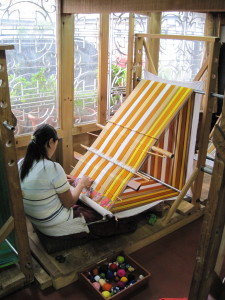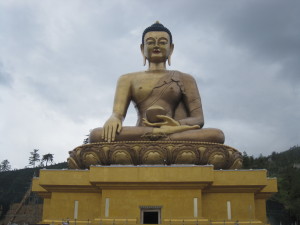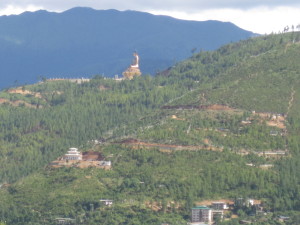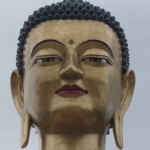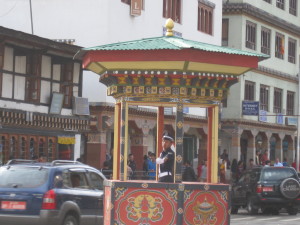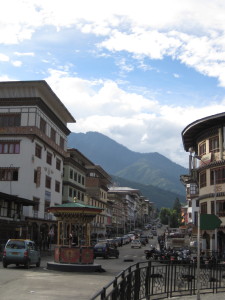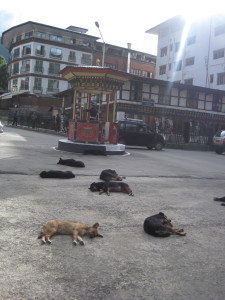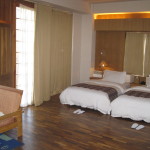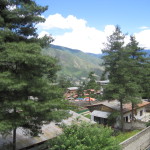Bhutan – Happiness is a Place.
This is the national motto and something you really feel as everyone is just happy and trying to be helpful and help you be happy. As Bhutan is a small country with only 7 million people, and the capital city of Thumphu only has 700,000 people and not a single stoplight. More on the stoplight later. I was lucky to have my friend Mark joined for the eight days in Bhutan as we are off to explore.
- The process to even arrive in Bhutan and set travel arrangements was quite a different experience that I had to research and learn more about. As I know others will ask me, I set up some of the basics on my “Visa and Entry Processes” page. See #3 for Bhutan.
We were met at the airport by our Guide Pema and driver Jimmy and were off in our SUV. From the start, I was impressed with the professionalism of greeting, information as we started to drive just had a very warm first impression. Pema was the man I had been emailing about the tour for the last couple months to get this all set up, and I was glad to see that he was also going to be our guide. He told us we were going to drive to the capital city of Thimphu, which is also where he lived. In route, we had one stop which was nice as we had been up and traveling for almost 8 hours.
Hike Tamchog Temple:
To reach this temple we had to cross a chain link bridge. I hadn’t ever seen a bridge quite like this and wasn’t sure about how stable it was. I was wearing my flip flops and was a little worried they may get stuck in the large holes in the bridge and/or fall in. It also was a very bouncy bridge. Mark and I looked at the bridge and it was a good distance across. I watched Pema just cruise across very easily and soon started myself. I felt like a penguin as I waddled with my feet pointed outward. Why? I felt a little more stable doing this and also thought my flip flops may not fall through.
On the other side, we were greeted with our first temple, beautiful hillsides landscapes, cypress trees (which is the national tree of Bhutan) and then our first billy goat. We came out of the temple and I just saw this goat standing up by a chorten. Not sure why, but I just liked him.
The National Animal – The Takin
We stopped at The Takin Preserve as the national animal is the Takin. This animal is a very rare mammal that only lives above 4,000 meters in the northwestern part of the country. This preserve is trying to help increase the population. We were able to see about 25 Takins living in a very large wildlife area along with some little baby Takins. It was fun to see some of the males get territorial around new food being thrown into the area and watch them move as they are somewhat awkward animals.
Our First Nunnery – and First Paparazzi Experience:
We stopped into to visit our first nunnery in the country which was a very similar to the Monastery, except it was all nuns. It seems fairly quiet and we hadn’t seen any nuns yet. When we exited the main temple and were putting our shoes back on, my first paparazzi experience happened. All of a sudden a little nun came bursting out of a side building and came right up to us. I was standing there with my shoes on and she looked at me, said wait and raised her finger and said wait and then she aimed her camera phone at me and took my photo and then another one. It was such a funny experience as word must have spread that we were there. Not sure if it was the blond hair, light skin or blue eyes, but she wanted just my photo
Paper Making Factory – While I visited a paper making factory in Sri Lanka (where they used Elephant dung), this process was a little different. They had to boil the plant fibers for 6-7 days to soften them when I recall the elephant dung process was much faster since the elephant had already digested the trees). It was interesting to watch the woman inside starting the process of making the sheets of paper, allowing all the water to drain out, then be pressed out by the weight, then eventually dried on the electric heaters for about 3-4 minutes. In the end, the papers they made were quite beautiful.
Thursday, June 26th
Hike to the top of Chari Monastery:
The next morning, Pema told us we were going to take a “short hike” to Chagri Dorjeden. This was the first monastery established in Bhutan in 1620. Mark and I asked, “what does a short hike mean to you and what sort of hiking attire should we wear?” Pema said it was about an hour up and it was fairly steep so active hiking attire would be best. We also forgot about the altitude we were at as this would make it more challenging.
So off we went to hike. It was a beautiful hike up, and up and up a little more. We had to stop many times to catch our breath but when we reached the top, it was worth it. We also reached the Monastery right as it started to drizzle and then when we were in the temple, it started to downpour rain.
So we waited from the upper balcony while it rained and watched the monks rejoice with the rain. We noticed they were bringing all sorts of big buckets out to the courtyard and placing by the drains from the roofs. We later learned they collect this rain water for bathing as they don’t have running water.
I later learned they didn’t have running water when I asked Pema to if there was a toilet that I could use before we left. Pema warned me it would not be “so nice like the hotel”. I said, “that is ok…I can deal and I’m sure I’ve seen worse”. Pema was right…it was not a nice toilet, there was no running water or a sink to wash my hands and I’m glad I have my Purell in my bag for these kind of situations.
The walk down the mountain in the rain was quite beautiful as it looked like we were in a cloud forest. I got this photo of Pema ahead of me with the trees and the clouds coming in and it was just amazing wherever we looked. Again, very worth the journey.
We had a little more sightseeing that afternoon in Thimphu including the following:
Little old man…you shouldn’t be touching my knee like that!
While visiting the National Memorial Choten I had an odd interaction with a little old man. So to start, this Choten is a large stupa and the most visable religious stupa in the city. IT was build as a memorial the the third king (the fifth king is now ruling). Throughout the day, people come here and walk around the stupa whirling prayer wheels in their hands. Everyone walks in one direction. I had asked Pema if we needed to bring anything else to wear for this (as we just came from our hike in shorts). He said no, we did not need other clothes here. So as we were standing aside listening to Pema talk about the memorial, the little old man comes up to us and looks at us, then at me. He then looks at my knees which are exposed. He then cups my right knee cap likes he was sizing it up. It was odd but my first thought was oh no… was I supposed to wear something covering my knees? Then he does the same thing to my left knee. All the same time Pema and Mark are standing with me and it wasn’t dangerous (as he was a little, frail 80 man). Then he turns to Mark, who also is wearing shorts and looks at his knees. I don’t recall if he actually touched his knees or not. Then the little man speaks in the local language to Pema and Pema translates. Essentially Pema told us the little man said I have very strong legs and would be able to “beat up” both Mark and Pema. We started to laugh and I didn’t believe him. I later asked again and Pema said that was what he said. What was even odder, as we started to walk around the stupa with the locals listening to more from Pema, the little man started to follow us. He walked very slowly so he would catch up to us and wait with us and then we would move on and he would continue to follow.

The little old man that touched my knee and told me I could “Beat up Mark and Pema” as I had strong legs
I also liked to see all the locals that were just enjoying each other company at the memorial as you can see by this bunch of ladies. They took cover from the rain and were just enjoying time together.
Weaving Center
Traditional attire is very important to the Bhutan culture. Locals are expected to wear it anytime they go to government offices, schools or formal occasions. The men’s attire is called the “Gho” and the women wear the “Kira”. Most of this is made on a weaving loom and we visited one of the weaving centers. Some of the patterns they were weaving were quite complex and we were told could take up to 9 months to complete.
Giant Bronze Buddha Dordenma
From a far, we could see this giant gold Buddha statue up on the hill. I had no idea at the time that it was still under construction and that it was going to be the largest in the world when it was done. So we made the drive up to visit. My first thought as we walked around the unfinished site was we would never be allowed to do this in the US as all the open holes in the ground were a huge liability. In Bhutan, it’s much easier. Enter at your own risk, walk carefully and enjoy it if you like. I kinda like that option. So we looked around and this Buddha was huge and almost done. It will measure 51.5 meters (169 feet). Once finished, this main statue will contain over 100,000 Buddha’s that are 8 inches tall and 25,000 Buddha’s that are 12 inches tall. So that’s 125,001 Buddha’s at once. It was pretty amazing to see up close and a great view point for the city.
No Stoplight in the Capital City?
With a city of 700,000 people, there are no stoplights to direct traffic. The locals just follow traffic laws and give way to each other. It’s only in the center of town where there is one traffic circle that is manned by a policeman. This policeman stands in a booth and directs traffic with hand signals. Pema told us that the city put a stop light in at one point, but the locals didn’t like it and it was removed and the policeman was but back in place. I was laughing as the stray dogs of the town know this is a safe place to sleep as it’s a one way street so to one part of the busiest traffic circle in town, the dogs know its safe to sleep there so I had to get a photo of that.
So that’s it for our time in the capital city of Thimphu. Heading west in the morning to the Punakha Valley
Logistics:
Tour Company: Please contact Pema as he is the owner of Bhutan Leading Travel and he was the guide that took us out on our 8 days. He has been leading tours since 1998 and is a Sr. Cultural and Trekking Guide for Bhutan. You can email Pema at: pematangbi@gmail.com or visit the website at www.bhutanleadingtravel.com
Bhutan Peaceful Resort – www.bhutanpeacefulresort.com
